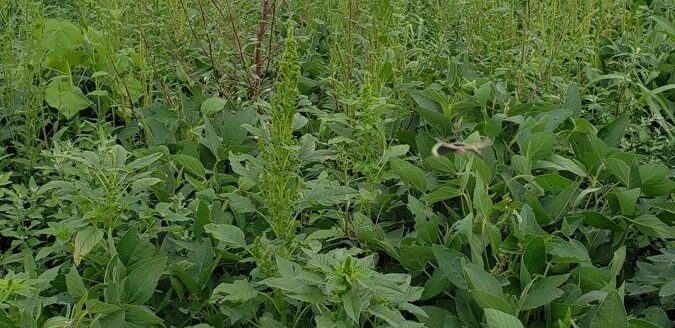Marestail and pigweed are some of the most dreaded weeds for crop producers across North Central Kansas, especially when they grow in soybean fields. Controlling these weeds, before they reach four inches in height, is of utmost importance, and if you can get to them before they are two inches tall it is better yet. Pre-emergent herbicides are great, if they are activated by timely rainfalls. They typically last between four to five weeks before the second round of weeds start to grow. However, with glyphosate resistance in both marestail and pigweed, the options for broadleaf weed control in soybeans is greatly reduced.
Marestail is difficult to kill when it enters the rosette stage (growth near the ground before vertical growth, also known as “bolting”), and it becomes even tougher to kill as it grows over six inches tall. Glyphosate resistance in marestail does not seem to be as severe as glyphosate resistance in pigweeds. Much of the time, even glyphosate resistant marestails are not completely resistant to glyphosate. That being said, one of the best tank mixes for post-emergent control of marestail in soybeans is a tank-mix of glyphosate with an ALS (acetolactate synthase) herbicide labelled for soybeans (i.e. FirstRate). The two together synergize the effect on marestail better than they do individually. The caveat being many marestails have also formed an ALS resistance which reduces the efficacy of herbicides—such as FirstRate, Classic or Synchrony.
Pigweeds (i.e. waterhemp, redroot pigweed, and palmer amaranth) have developed a very strong resistance to glyphosate and to ALS herbicide, which often leads to fewer herbicides to control these pesky weeds. Many Group 14 herbicides (i.e. Cobra, Flexstar, Ultra Blazer) or the “burners,” are great at controlling many of the pigweeds in soybeans, but again taller weeds are more difficult to control.
Moreover, if Liberty Link Soybeans were planted, a glufosinate herbicide can be used to control pigweeds, especially when they are under four inches in height. A couple things to remember when using glufosinate (i.e. Liberty): high spray volumes and double applications improve the weed control efficacy. Double applications should also be highly considered if one of the applications used a Group 1 herbicide, such as clethodim (i.e. Select), to control grass when a tank was mixed with glufosinate. Clethodim and glufosinate seem to adversely affect each other’s effectiveness in controlling their respective weeds.
If Xtend Soybeans were planted, dicamba products such as Engenia, Xtendimax and FeXapan can be used to control pigweeds effectively, if they are under four inches tall. If you have any questions feel free to stop by or contact me in the Concordia Office (River Valley Extension District, 811 Washington, Suite E, Concordia, Kansas 66901) by calling 785-243-8185 or emailing [email protected].

